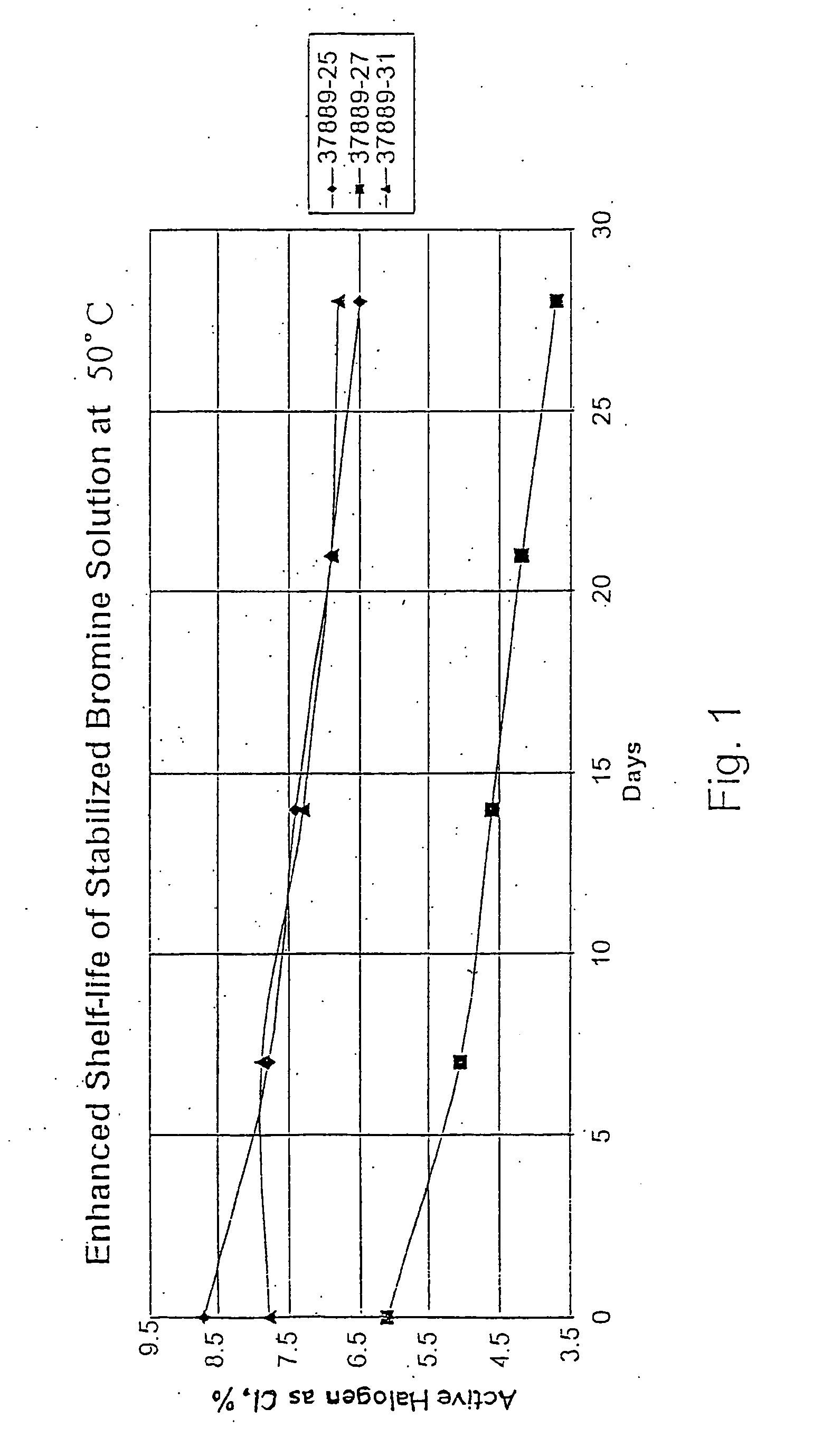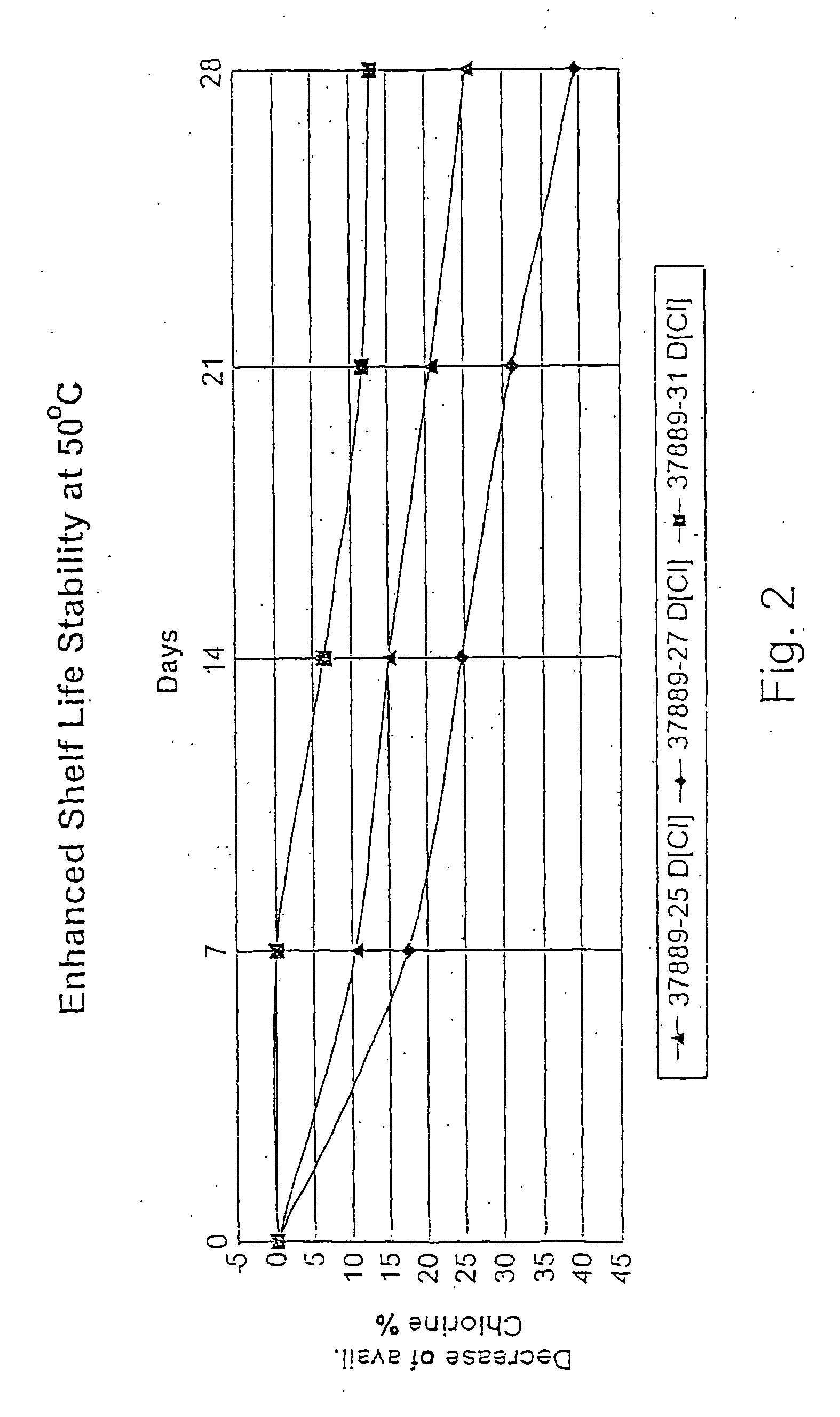Process for the preparation of concentrated solutions of stabilized hypobromites
a concentrated solution and stabilized technology, applied in the direction of halogen oxide/oxyacid, water/sewage treatment by oxidation, other chemical processes, etc., can solve the problems of slow precipitation, insufficient stable for practical and commercial application, and the disadvantage of yielding equivalent amounts of naobr and nacl of hypochlorite, etc., to achieve the effect of higher stability
- Summary
- Abstract
- Description
- Claims
- Application Information
AI Technical Summary
Benefits of technology
Problems solved by technology
Method used
Image
Examples
example 1
[0030] A concentrated hypobromite solution is prepared by contacting, under vigorous stirring, 255.8 g of a concentrated aqueous NaOH solution (34.76 wt %) with 160 g bromine, added gradually so that the temperature is maintained at 0±5° C. The NaOH / bromine molar ratio is 2.2:1. A clear, dark yellow solution of unstabilized sodium hypobromite is obtained, which contains 28.62 wt % NaOBr and 24.8 wt % NaBr. In spite of the very high concentration and low temperature, no precipitation occurred due to the very high solubility of NaBr.
[0031] An aqueous solution of sodium sulfamate is prepared by gradually adding at room temperature 789.4 g of an aqueous, 50 wt % NaOH solution to 1418 g of an aqueous slurry composed of 576 g sulfamic acid and 842 g of water. A clear solution containing 32 wt % of sodium sulfamate is obtained. 409 g of this sulfamate solution is added gradually to the solution of unstabilized sodium hypobromite, while maintaining the temperature at a maximum of 5° C. The...
example 2
[0032] In a 1000 ml jacketed reaction vessel, provided with stirrer and temperature controller, is added 272.4 g (208 ml) of 32.3% aqueous NaOH solution. The solution is cooled, by means of −15° C. brine, down to 0±5° C. under stirring. Bromine, 160 g (51.5 ml) is added drop-wise, so that the temperature does not rise beyond 5° C. When the bromine addition is accomplished, 340.7 g of a solution of sodium sulfamate, prepared from 818.4 g (500 ml) 50 wt % NaOH solution, 1144.4 ml water and 900.8 g sulfamic acid, is added. Once the addition of the sodium sulfamate solution is finished, 564.4 g of aqueous sodium hypochlorite solution (12.5% available chlorine) containing 10.3 wt % NaCl is added, followed by other 340.7 g of the aforesaid sodium sulfamate solution. Throughout the process, the temperature is maintained at 0±5° C.
[0033] The final solution contained 14.3 wt % NaOBr (8.6% halogen expressed as chlorine) and the molar ratio Na sulfamate / NaOBr is 1.1:1. The stability of this s...
example 3
[0034] A NaOBr / NaBr solution is prepared as in the first stage of Example 2.291 g of a 45 wt % sodium sulfamate solution, prepared from the same amount of sulfamic acid and aqueous 50 wt % NaOH as in Example 2, but with only 381 g of water, is added gradually at 0±5° C. The stabilized NaOBr / NaBr solution has an available chlorine concentration as high as 11.3% and its composition is 18.9 wt % NaOBr, 16.4 wt % NaBr and 20.9 wt % sodium sulfamate.
PUM
| Property | Measurement | Unit |
|---|---|---|
| temperature | aaaaa | aaaaa |
| temperature | aaaaa | aaaaa |
| temperature | aaaaa | aaaaa |
Abstract
Description
Claims
Application Information
 Login to View More
Login to View More - R&D
- Intellectual Property
- Life Sciences
- Materials
- Tech Scout
- Unparalleled Data Quality
- Higher Quality Content
- 60% Fewer Hallucinations
Browse by: Latest US Patents, China's latest patents, Technical Efficacy Thesaurus, Application Domain, Technology Topic, Popular Technical Reports.
© 2025 PatSnap. All rights reserved.Legal|Privacy policy|Modern Slavery Act Transparency Statement|Sitemap|About US| Contact US: help@patsnap.com


